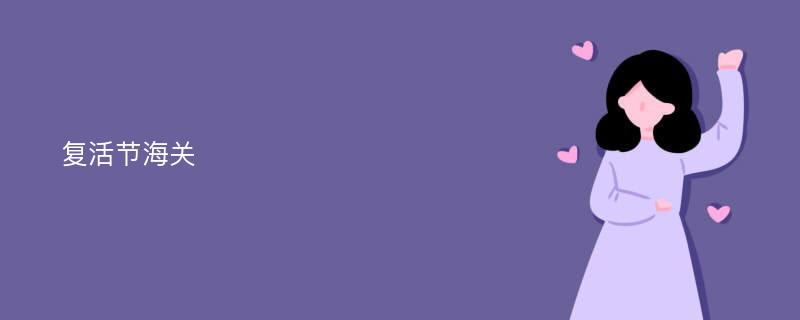
Easter Customs,本文主要内容关键词为:Easter论文,Customs论文,此文献不代表本站观点,内容供学术参考,文章仅供参考阅读下载。
What Is Easter?
Next to Christams,Easter is the most important andbeloved holiday in the western countries.It is the time ofthe holiest of the Christian holidays—the resurrection of theChrist(基督复活)—the light of the world! It is also thetime of the coloring of Easter eggs,the coming of the Easterbunny(rabbit),the surprise of Easter baskets,the bloomingof spring flowers,the birth of baby animals,the wearing ofbright new clothing,and the buying of a new spring bonnet (小圆软帽).Easter has no fixed date.It is always celebrated onthe first Sunday following the full moon which appears on orafter the vernal equinox(春分),about March 21.
Customs,symbols,and Behavior of Easter
1.Ester Eggs
The egg has been a symbol of wonder and mystery to humanbeings since time began.Out of a seemingly lifeless objectwhich looked like a stone,popped a living and breathingcreature! It seemed to be a magical and mystical thing indeed.This strange object was so miraculous (神奇的)that ancientpeoples everywhere attributed wonderful qualities to it.
The coloring of eggs has a long history.From the earliestof times people colored their Easter eggs with dyes.Thedesigns stood for certain things,for instance, a sun meantgood luck,a hen or rooster was said to make wishes come true,a deer showed good health,and flowers were intended to wishlove and beauty.These eggs could be decorated and kept foryears as little treasures.
Easter eggs were often associated with a magical power.One old myth said that Easter eggs buried in the groundafter Easter would make the grapevines grow well.People alsosaid that if you buried an Easter egg which was laid on GoodFriday,it would turn into a diamond in 100 years.Eggs weretaken to the church and blessed by the priest,and these eggswere thought to have special properties.
2.Easter Baskets
Early on Easter morning,children in many Christiancountries get up and begin to search throughout the house theEaster baskets that their parents have hidden so carefullyduring the night.The young children believe that the basketshave been brought to them by"Easter Bunny" during the nightwhen they were asleep,so they have great fun in finding them.The inside of the baskets is stuffed with(装有) candy eggs,chocolate bunnies(兔),decorated hard- boiled eggs,littlefurry bunny toys,etc.
3.Easter Bunny
The Easter Bunny or Rabbit is associated with Easterbecause rabbits were the most fertile animals known to theearly pagans.They were symbols of fertility and new life.Also,the hare,according to Egyptian mythology (神话), was asymbol for the moon.In many countries in Europe, childrenmake little nests outdoors for the Easter Rabbit to fill withcolored eggs.The Easter Rabbit has never had a Christianizinginfluence.It is one of the few symbols of Easter which hasnot been given a religious significance.
4.Other Easter Animals
Easter Lamb is the most important symbol of Christianreligions during Easter because Jesus is called" the Lamb of God".In order to save the world,Jesus died to serve as
thesacrificial lamb.A roast lamb is a very common Easter mealtoday.
The Easter Chick is the most common symbol of the newlife from an egg.Other animals that come from eggs are alsosymbolic of Easter:the duck,the swan,and the goose.
The butterfly is one of the most often used symbols durngEaster time.It represents a metamorphosis(蜕变)from birthto death,and to rebirth,through its life cycle.The caterpillar(幼虫)stands for life,the cocoon (茧)stands for death,and the butterfly stands for rebirth.The Christians have used this sysmbol as the resurrection of Christ.
5.Easter Clothes and Hats
Easter is the time of wearing brand-new clothes.New shoes,suits,dresses,coats,and bonnets are a sign of spring.Itis believed to be bad luck not to wear something new at Easter.Even a new ribbon for the hair,or a new pair of shoes will do.In the old days when winter was cold and harsh,people likedto put away their old,heavy winter garments,and put on fresh,new,clean clothing.The first early Christians were baptized(洗礼)in water the week before Easter.They were givenbright new white robes to wear to symbolize (象征)theirrebirth in Christ.Later on,everyone was expected to wear newclothes at Easter whether he or she was baptized or not.
A young man who fancied a young girl might give her a pairof gloves for an Easter present.If she wore them on EasterSunday,it meant that she favored him.It could even mean anengagement was forthcoming.
In the old days,people liked to wear their new clothesto church,and then afterwards,to take a walk through thetown,fields,and countryside to smell and appreciate all thebright and colorful spring flowers and trees.They oftenparaded together,singing, and saying prayers.Today, theEaster parade is a common event in many cities in America.They do not stop to pray and sing hymns anymore,but theystill like to get dressed up in their Easter clothes, andmarch down the streets with their top hats and new Easterbonnets on.
6.Easter Colors
Easter colors are the colors of spring:White-the color ofpurity and joy.Early Christians were often baptized duringthe Easter time.They wore new white clothing as a symbol oftheir new life.Many Easter flowers are white:lily(百合),thenarcissus(水仙),and many others.
Yellow-Yellow is the color of the sun.It is one of themost popular colors for Easter; it represtents light, life,sunlight,radiance,and the yellow of chicks and daffodils (黄水仙)—all spring arrivals.It also stands for the light ofChrist who is usually portrayed with a yellow aura of lightcoming form his person.
Green-Green is the color of nature.It stands for eternalhope for the death of winter and the rebirth of spring.
Purple-Purple is the color of kings.It is a symbol of thekingship of Christ.It also stands for mourning.The Christianreligion is in mourning during the time of Christ's death.
